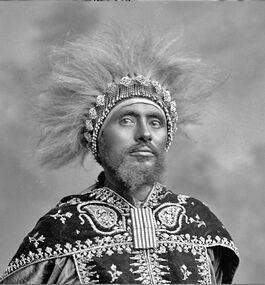Alphonse Amsalu: Difference between revisions
No edit summary |
No edit summary |
||
| Line 5: | Line 5: | ||
|image = Amsalu_1871.jpg | |image = Amsalu_1871.jpg | ||
|image_size = 265px | |image_size = 265px | ||
|caption = Amsalu in | |caption = Amsalu in 1877 | ||
|birth_date = {{birth date|1838|6|19}} | |birth_date = {{birth date|1838|6|19}} | ||
|birth_place = Albertsville, Comté-du-Roi, [[Garambura|Baséland]]<br>(now Mbiza, [[Garambura]]) | |birth_place = Albertsville, Comté-du-Roi, [[Garambura|Baséland]]<br>(now Mbiza, [[Garambura]]) | ||
Revision as of 17:35, 6 January 2020
This article is incomplete because it is pending further input from participants, or it is a work-in-progress by one author. Please comment on this article's talk page to share your input, comments and questions. Note: To contribute to this article, you may need to seek help from the author(s) of this page. |
Alphonse Amsalu | |
|---|---|
 Amsalu in 1877 | |
| Born | June 19, 1838 Albertsville, Comté-du-Roi, Baséland (now Mbiza, Garambura) |
| Died | January 12, 1887 (aged 48) Sainte-Germaine, Baséland |
| Buried | Mbiza, Garambura |
| Allegiance | |
| Service/ | Navy |
| Years of service | 1863–1870 1875–1887 |
| Rank | Vice-Admiral |
| Battles/wars | War of the Arucian |
Vice-Admiral Alphonse Amsalu (19 June 1838–12 January 1887; aged 48) was a Yebase Gaullican sailor, philosopher and author. He is well-noted for his early contributions to the philosophy of Pan-Bahianism, and laid some of the philosophical framework for the movement, most notably the unification of all Bahians against the institution of Toubacterie. He was also the commander of NMS Sinéad when it fired upon and sunk the NMS Insulaire during the Sougoulie rebellions of 1883. He was renowned for his combat experience, having been instrumental in naval victories in many global wars such as the War of the Arucian, X and X. He was executed for treason off the coast of Sainte-Germaine for sinking the Insulaire in 1887, along with most of his crew.
Amsalu was born into a noble Yebase family with military history in the colony of Baséland (now Garambura) in 1838. His father was Jean-Luc Amsalu, who served as Mayor of Comté-du-Roi when Amsalu was a child. They moved to Sainte-Germaine for his father's career in 1846, where Amsalu developed his interest in the navy. After stints of unsuccessful applications, Amsalu finally joined the navy in 1863; aged 25. Quickly witnessing some of Gaullica's oppressive policies towards Bahian natives, Amsalu began advocating for pan-Bahian solidarity in some of his early works, the most notable of which is Un cas pour la résistance de Bahiaux, which he published in 1869. In 1870 he was discharged from the navy for publishing the book but was re-conscripted in 1875 following a manpower shortage in the colonies. He was posted in the Arucian Strait for the initial period of his second tenure, serving around Sanslumiere and Satucin, as well as participating in the Battle of Sant'Amanzio in the War of the Arucian in 1883, before quickly being re-posted to the Gulf of Deselle due to the outbreak of the Sougoulie rebellions. Amsalu famously sunk the Insulaire in solidarity with the rebellions, although this was not discovered until the journal of Daniel Tamrat Tegene was discovered in 1886. He was executed by drowning in 1887, and his body was recovered in 1892 and buried in his hometown of Albertsville.
Amsalu is one of the famous and renowned heroes of Bahian independence and pan-Bahianism, having memorials across Bahia but being particularly revered in Mabifia, Rwizikuru and Garambura. Amsalu's significance in starting the rise of pan-Bahianism and his contributions to the Sougoulie have kept his legacy highly influential.